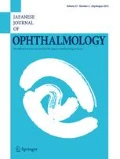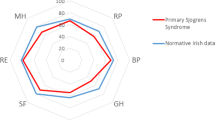Abstract
Purpose
This study was performed to assess the impact of dry eye on patients’ quality of life (QOL) and to analyze the association between subjective symptoms and ocular surface findings of dry eye.
Methods
The study population consisted of 158 patients with dry eye aged 20 years or older who visited any of the 15 medical care facilities enrolled in the study. The backgrounds and ocular findings of the patients were investigated, and their QOL was evaluated with the Japanese version of the 25-item National Eye Institute Visual Functioning Questionnaire (VFQ-25) and of the Medical Outcomes Study (MOS) 8-item Short-Form Health Survey (SF-8) to examine the association between subjective symptoms and ocular surface findings.
Results
Of the patients enrolled, 15 were men and 143 were women, and their average age was 62.5 ± 12.6 years. Sixty patients (38.0%) had comorbid Sjögren syndrome (SS). The results of Schirmer testing, fluorescein staining, and rose bengal staining for SS patients were significantly worse than those for the non-SS patients, but the VFQ-25 and SF-8 scores were not significantly different between the SS and non-SS patients. In the ocular surface findings, a weak association between the fluorescein staining scores and general vision scores, a subscale of the VFQ-25, was found. However, the ocular surface findings and VFQ-25/SF-8 results in the simple correlation analysis as well as in the multiple linear regression analysis showed no significant associations.
Conclusions
Ocular surface findings and QOL scores of patients with dry eye appear to disagree. Therefore, it is necessary to address subjective symptoms and QOL scores in addition to examination findings when evaluating dry eye.
Similar content being viewed by others
References
Pflugfelder SC. Prevalence, burden, and pharmacoeconomics of dry eye disease. Am J Manag Care 2008;14:S102–106.
Yamada M. Dry eye syndrome: concept, pathogenesis, and therapeutic modalities based on the new definition. J Jpn Ophthalmol Soc 2008;113:541–552.
Miljanovic B, Dana R, Sullivan DA, Schaumberg DA. Impact of dry eye syndrome on vision-related quality of life. Am J Ophthalmol 2007;143:409–415.
Schiffman RM, Walt JG, Jacobsen G, Doyle JJ, Lebovics G, Sumner W. Utility assessment among patients with dry eye disease. Ophthalmology 2003;110:1412–1419.
The International Dry Eye Workshop. The definition and classification of dry eye disease: report of the Definition and Classification Subcommittee of the International Dry Eye WorkShop (2007). Ocul Surf 2007;5:75–92.
Hay EM, Thomas E, Pal B, Hajeer A, Chambers H, Silman AJ. Weak association between subjective symptoms or and objective testing for dry eyes and dry mouth: results from a population based study. Ann Rheum Dis 1998;57:20–24.
Nichols KK, Nichols JJ, Mitchell GL. The lack of association between signs and symptoms in patients with dry eye disease. Cornea 2004;23:762–770.
Nichols JJ, Mitchell GL, Nichols KK. An assessment of self-reported disease classification in epidemiological studies of dry eye. Invest Ophthalmol Vis Sci 2004;45:3453–3457.
Nichols KK, Mitchell GL, Zadnik K. Performance and repeatability of the NEI-VFQ-25 in patients with dry eye. Cornea 2002;21: 578–583.
Schiffman RM, Christianson MD, Jacobsen G, Hirsch JD, Reis BL. Reliability and validity of the ocular surface disease index. Arch Ophthalmol 2000;118:615–621.
Shimazaki J, Tsubota K, Kinoshita S, et al. Definition and diagnosis of dry eye 2006. Atarashii Ganka (in Japanese) 2007;24:181–184.
Nichols KK, Smith JA. Association of clinical diagnostic tests and dry eye surveys: the NEI-VFQ-25 and the OSDI. Adv Exp Med Biol 2002;506:1177–1181.
Vitale S, Goodman LA, Reed GF, Smith JA. Comparison of the NEI-VFQ and OSDI questionnaires in patients with Sjögren’s syndrome-related dry eye. Health Qual Life Outcomes 2004;2:44.
Smith JA, Vitale S, Reed GF, et al. Dry eye signs and symptoms in women with premature ovarian failure. Arch Ophthalmol 2004;122:151–156.
Nichols KK, Nichols JJ, Mitchell GL. The reliability and validity of McMonnies dry eye index. Cornea 2004;23:365–371.
Buchholz P, Steeds CS, Stern LS, et al. Utility assessment to measure the impact of dry eye disease. Ocul Surf 2006;4:155–161.
Mangione CM, Lee PP, Gutierrez PR, Spritzer K, Berry S, Hays RD. Development of the 25-item National Eye Institute visual function questionnaire. Arch Ophthalmol 2001;119:1050–1058.
Suzukamo Y, Oshika T, Yuzawa M, et al. Psychometric properties of the 25-item National Eye Institute visual function questionnaire (NEI VFQ-25), Japanese version. Health Qual Life Outcomes 2005;3:65.
Fukuhara S, Ware JE, Jr., Kosinski M, Wada S, Gandek B. Psychometric and clinical tests of validity of the Japanese SF-36 health survey. J Clin Epidemiol 1998;51:1045–1053.
Ware JE Jr, Sherbourne CD. The MOS 36-item short-form health survey (SF-36). I. Conceptual framework and item selection. Med Care 1992;30:473–483.
Mertzanis P, Abetz L, Rajagopalan K, et al. The relative burden of dry eye in patients’ lives: comparisons to a U.S. normative sample. Invest Ophthalmol Vis Sci 2005;46:46–50.
Oshika T, Sugita G, Hayashi K, et al. Influence of cataract and intraocular lens surgery on health-related quality of life. J Jpn Ophthalmol Soc 2005;109:753–760.
Varma R, Wu J, Chong K, Azen SP, Hays RD. Impact of severity and bilaterality of visual impairment on health-related quality of life. Ophthalmology 2006;113:1846–1853.
Goto T, Zheng X, Klyce SD, et al. A new method for tear film stability analysis using videokeratography. Am J Ophthalmol 2003;135:607–612.
Kaido M, Dogru M, Ishida R, Tsubota K. Concept of functional visual acuity and its applications. Cornea 2007;26:S29–35.
Kaido M, Dogru M, Yamada M, et al. Functional visual acuity in Stevens-Johnson syndrome. Am J Ophthalmol 2006;142:917–922.
Kojima T, Ishida R, Dogru M, et al. A new noninvasive tear stability analysis system for the assessment of dry eyes. Invest Ophthalmol Vis Sci 2004;45:1369–1374.
Kimura T, Yokoyama A, Kohno N, Nakamura H, Eboshida A. Perceived stress, severity of asthma, and quality of life in young adults with asthma. Allergol Int 2009;58:71–79.
Chia EM, Wang JJ, Rochtchina E, Smith W, Cumming RR, Mitchell P. Impact of bilateral visual impairment on health-related quality of life: the Blue Mountains Eye Study. Invest Ophthalmol Vis Sci 2004;45:71–76.
Begley CG, Chalmers RL, Abetz L, et al. The relationship between habitual patient-reported symptoms and clinical signs among patients with dry eye of varying severity. Invest Ophthalmol Vis Sci 2003;44:4753–4761.
Schein OD, Tielsch JM, Munoz B, Bandeen-Roche K, West S. Relation between signs and symptoms of dry eye in the elderly. A population-based perspective. Ophthalmology 1997;104:1395–1401.
Lin PY, Cheng CY, Hsu WM, et al. Association between symptoms and signs of dry eye among an elderly Chinese population in Taiwan: the Shihpai Eye Study. Invest Ophthalmol Vis Sci 2005;46: 1593–1598.
McCarty CA, Bansal AK, Livingston PM, Stanislavsky YL, Taylor HR. The epidemiology of dry eye in Melbourne, Australia. Ophthalmology 1998;105:1114–1119.
Author information
Authors and Affiliations
Consortia
Corresponding author
About this article
Cite this article
Mizuno, Y., Yamada, M., Miyake, Y. et al. Association between clinical diagnostic tests and health-related quality of life surveys in patients with dry eye syndrome. Jpn J Ophthalmol 54, 259–265 (2010). https://doi.org/10.1007/s10384-010-0812-2
Received:
Accepted:
Published:
Issue Date:
DOI: https://doi.org/10.1007/s10384-010-0812-2



